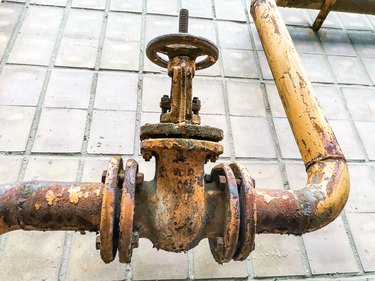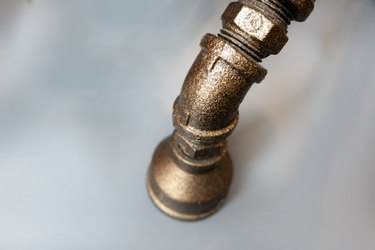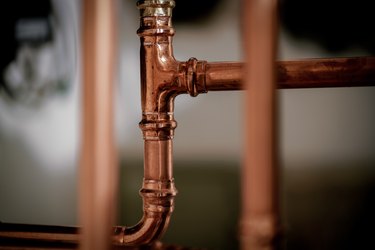
Galvanized steel pipe seemed to be a good idea when it was introduced as a replacement for lead pipes that were common in the early 20th century. It took many years, but now plumbers know (as does everyone else) that galvanized pipes present serious problems for homeowners, not the least of which is that they are probably contaminated with lead.
Even though plumbers largely started using copper pipes for new installations in the 1960s, galvanized pipes remained widely in use, and they are still available, although these days, people use them mostly for landscaping and other outdoor applications. Considering that galvanized pipe has an expected service life of 50 to 80 years, the galvanized piping in homes built in the mid-20th century and before is now ready for replacement.
Video of the Day
Video of the Day
The question for homeowners is whether you should simply replace spent galvanized pipes or whether you should replace your entire pipe system with copper or PEX. Even though repiping an entire home is a big project that can cost $15,000 or more and take up to a week — during which time you have to stay out of the house — it's still a good idea, and it's one your plumber will probably recommend. Once you understand galvanized pipes and the problems they create, you'll see why.
What Is Galvanized Steel Pipe?
Galvanizing is the process of coating steel with a layer of molten zinc to protect it from corrosion. The first examples of galvanizing were found in Indian armor dating back to the 18th century. The process was patented in Paris, France in 1837 by Stanislas Sorel, who invented the first galvanizing paint.
Plumbers in North America began replacing lead pipe with galvanized steel pipe in the early 20th century. The pipe was produced by dipping steel pipe in a vat containing molten zinc, which effectively coated both the inside and outside of the pipe. Galvanizing gives the steel pipe a rough, flat, silvery finish, although this finish fades to a dull gray over time.
Like the lead pipe it replaced as well as other types of steel pipe, galvanized pipe and pipe fittings are threaded, which precludes simply cutting out a leaking section of pipe and replacing it, as you can do with copper or PEX. When one galvanized pipe needs replacing, a plumber often has to disassemble an entire section and reassemble it.
Galvanized Steel Pipe Isn't Lead-Free
Health authorities have known about the dangers of lead for centuries, but that didn't stop the widespread use of lead piping simply because it's malleable and strong — in short, an ideal pipe material. The introduction of galvanized pipe seemed to offer a safe alternative, but unfortunately, early versions of galvanized pipe did not eliminate the lead hazard from households.
One of the reasons is that zinc is a naturally occurring element that is often contaminated with other minerals, and lead is one of the most prominent. Pipes dipped in vats of molten zinc ended up having a significant concentration of lead, and as the zinc wore away from the inside of the pipe, the lead entered the drinking water. Galvanized pipes that conform to current ASTM standards don't contain lead, but pipes installed in older homes probably do.
Other Problems With Galvanized Pipe
Besides possibly containing lead, galvanized steel pipe creates other issues for homeowners, and most of these stem from the fact that the galvanized coating on the interior of the pipe gradually wears away.
- Loss of water pressure: When the zinc coating wears away, the interior of a galvanized steel pipe begins to corrode and rust. The buildup of rust and corrosion eventually creates a blockage in the pipe, restricting water flow and creating a loss of water pressure.
- Uneven water distribution: Depending on where the corroded pipe is located in the plumbing network, one or more fixtures may be affected. If a pipe supplying a bathroom faucet is corroded, that faucet will experience low pressure while all the other fixtures seem OK. If the corroded pipe supplies a section of the house, all the fixtures in that section will be affected.
- Discolored water: Rust from the inside of the pipe flakes off and falls into the water flowing through the pipe. The result is that the water at faucets has an unappealing brown coloration and a metallic taste and may even contain flecks of rusted metal.
- Leaks: Once corrosion has advanced sufficiently, galvanized steel pipes begin to leak. This leaking usually occurs first at fittings and threaded connections.
How to Identify Galvanized Pipes

Older galvanized steel pipes have a dull gray coloration that's fairly distinctive. One dead giveaway is that the ends of the pipes are threaded, so if you follow a particular pipe to a connection point, you should be able to see some of the threads extending out from the fitting.
The fact that the pipe itself is steel provides another easy way to identify galvanized pipe. Scrape away a small amount of the zinc coating with sharp implement, such as a flat-head screwdriver, and hold a strong magnet to the spot. If the pipe is galvanized steel and not copper or plastic, the magnet will stick to it.
Plumbers use galvanized steel pipe for drain lines as well as water lines, but because a drain line isn't pressurized and doesn't carry a potable water supply, it isn't as concerning as a galvanized water pipe. If you discover that some of your drain lines are galvanized, it isn't as much of a call to action as galvanized water lines. Pipe size also matters. Drain lines are larger and less likely to be blocked by corrosion than water lines.
Is Replacement Necessary?
Most plumbers would answer this question in the affirmative. If you don't replace your galvanized pipes now, you'll almost certainly have to do it in a few years because with few exceptions, they are reaching the end of their service life. If your galvanized plumbing isn't causing problems now, it soon will, and the pipes may start to leak, which could cause water damage and augment the pain that much more.
If your outdoor irrigation system incorporates galvanized pipes, you might not have to worry about them for now, particularly if they are 1 inch or larger in diameter. Keep an eye on them, though, because they can still leak, and if they are buried, the leaks might not be apparent until hundreds of gallons of water have been wasted.
Are There Alternatives to Replacement?
Some companies offer the option of blasting pipes with compressed air to dislodge rust and corrosion, but there are two drawbacks to this approach. The first is that dislodged rust can collect at plumbing bends or inside faucets, making a bad situation worse. The second is that the air may blast through weakened pipe joints and create leaks.
Continuing on this theme, it's possible to spray an epoxy coating into the pipes after air blasting, which would theoretically cover the corrosion and seal it. One company that used to do this no longer does because there's no way to get a camera into water pipes as you can for sewer pipes to verify that all parts of the pipe are covered. If any part of the pipe is left uncovered, the procedure won't work.
How to Replace Galvanized Plumbing

You can replace all or part of a galvanized plumbing network. The procedure typically involves cutting the pipes into pieces, which is much easier than unscrewing each pipe from its fitting. Once you've disassembled back to the water main or a suitably undamaged point in the plumbing system, you attach an adapter for a plumbing pipe material with better corrosion resistance, such as copper, PEX, or CPVC, and install a whole new pipe system.
That's the right way to do it, but it's expensive and time-consuming, so you may want to replace only those pipes that are causing trouble. You can cut out individual pipes and screw PEX, CPVC, or copper adapters into the fittings from which you remove those pipes, but there's one important caveat. If you choose copper pipes, you must use a special fitting called a dielectric union to keep the copper and galvanized steel separated. If you don't do this, the joint will quickly corrode and leak.
The Cost for Professional Replacement
Repiping an entire house, particularly a multistory one, is a big project that should be undertaken by only the most plumbing-savvy DIYer if not by a professional plumber. You can save a lot of money by doing the work yourself, and if you're working on your own, it's possible to do the job a little at a time to minimize disruption to the household. Most homeowners don't have the skills or the time to commit to such a massive project, and they will opt for professional replacement. The cost for professional replacement varies with the size of the home and, as a corollary, the size of the plumbing network. At the very low end, the job could end up costing around $1,500, and at the high end, costs could exceed $15,000.
Plastic pipes, including CPVC and PEX, are less expensive than copper, so opting for plastic significantly lowers the cost of the entire job, and because PEX is a little easier to install than CPVC and much easier than copper, it reduces the time the job takes as well. PEX is fairly new on the market, so its longevity is untested, although it's estimated to last more than 40 years. CPVC, on the other hand, lasts from 50 to 80 years. Copper lasts from 50 to 100 years, and stainless steel, the most expensive option, lasts over 100 years.
Homeowners should figure ancillary costs, such as drywall repair and repainting, into the final price tag. These typically aren't covered in the plumber's cost estimate.
- Washington Post: Do I Have to Replace All the Galvanized Pipes in My 1940s House?
- San Diego Plumbing and Pipelining: Considering Replacing Galvanized Pipes? Read This First!
- American Vintage Home: Why You Need to Swap Out Your Galvanized Pipes
- NuFlow: Should I Reline or Replace My Galvanized Steel Plumbing Pipes?
- CostHelper: How Much Does Replacing Galvanized Pipes Cost?